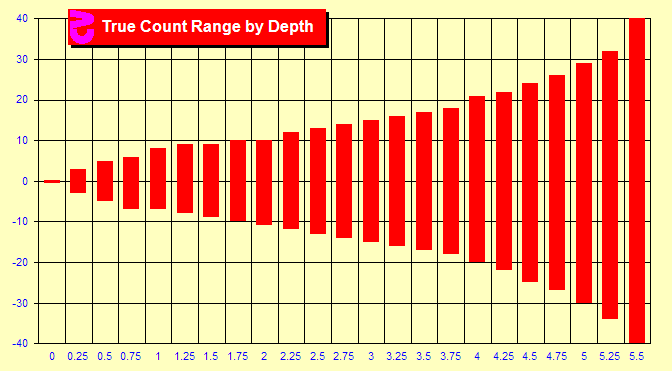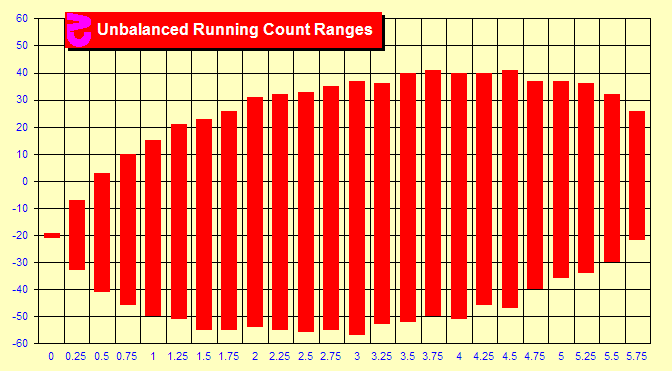|
|
Chapter 3. Data by Depth
| The first hand after a shuffle is not that much different for a
card counter or Basic Strategy player. As we travel more deeply into
the shoe, the game becomes more interesting. Let us take a quick look
at different depths before we start talking about penetration.
" It is not length of life, but depth of life."
— Ralph Waldo Emerson
| |
 Why
is depth important in Blackjack? Why
is depth important in Blackjack?
The deeper the dealer has dealt, the more information we have about
the remaining cards. However, the main reason that depth improves
advantage is the increase in count range. At the start of a shoe,
the count is always zero unless the dealer shows burn cards. The
advantage is negative. At the start of the second hand in a shoe,
there is a small chance that the count has increased enough to raise
your bet. The deeper we travel in the shoe, the more likely the
count is out of the ordinary presenting an opportunity to raise
the bet. In this chart we see the range of possible true counts
by section of a six-deck shoe in quarter-deck increments. We can
see that the range increases in both positive and negative directions.
We have no information at the start of the shoe. Later a positive
count is an opportunity to increase the bet and a substantial negative
count signals time for a bathroom break.
|
 What
about unbalanced counts? What
about unbalanced counts?
Running count strategies like KO, Red7 and KISS work essentially
the same except that the ranges move very differently. One weakness
of these strategies is the lack of opportunities near the start
of the deck where the count underestimates the advantage. However,
this is not as large a problem as many people believe because there
are not really that many opportunities in the early cards anyway.
From an Initial Running Count (IRC) of -20, we see that the upper
range of the count increases much more quickly than the lower range
as the imbalance in the card count values nudges the count upward.
Unlike the true count ranges, these ranges expand and then start
contracting again near the end of the shoe. This is because there
is a smaller range of possible running counts when the number of
remaining cards is low. There is a larger range of true counts at
deep penetrations because you are dividing by a smaller number.
|
|
Sim details
- Six decks, S17, DAS, LS, Heads-Up, Hi-Lo, truncate, exact cards
resolution, 90% Penetration
- Six decks, S17, DAS, LS, Heads-Up, KO-P, 90% Penetration
- Four hundred million rounds each
|
|
|
 Why
is depth important in Blackjack?
Why
is depth important in Blackjack? What
about unbalanced counts?
What
about unbalanced counts?